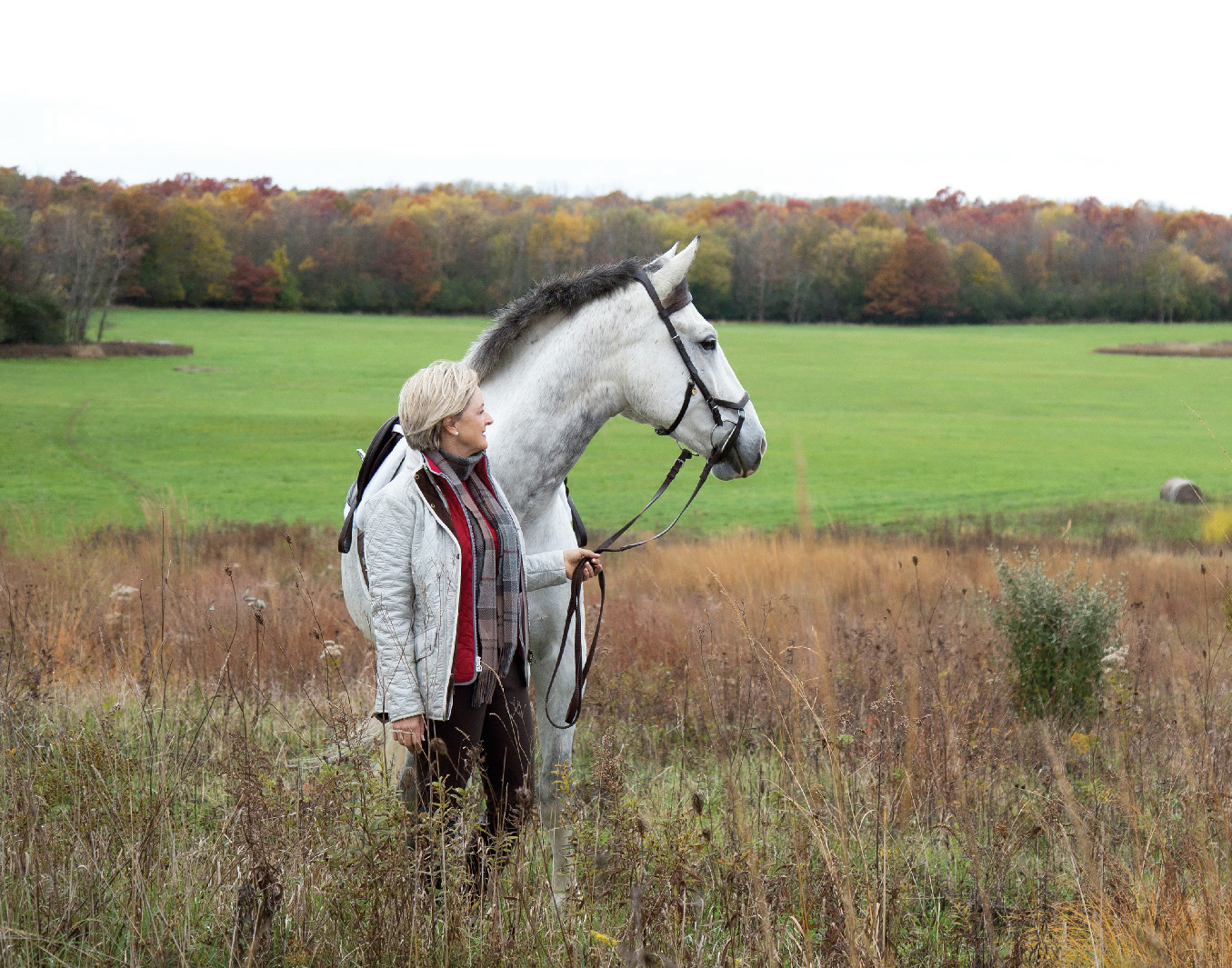
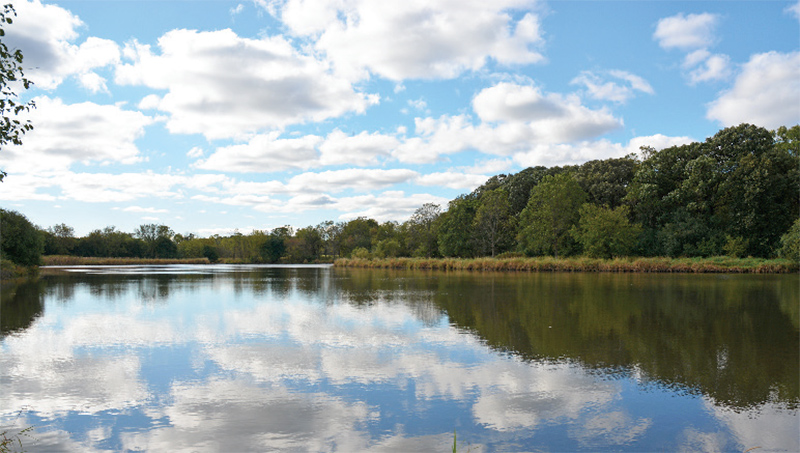
The story of this village that rolls over Vistas of fields, timbered enclaves, and Sparkling lakes unfolds in two acts of pioneering
The First Act is devoted to those rugged settlers who journeyed out by horse and wagon in the early 1830s to seek an auspicious place to set down their few possessions in largely uncharted territory. In spite of the struggles facing them, they looked with faith and hope to building a
new life.
The Second Act brings a new breed of pioneers. The land had been largely settled, the prairie broken, and the farms were now two or three generations on from those first explorers. These new pioneers of the early 20th century were mostly well-established in industry and business, but they, too, were seeking to create a new life with roots in the land.
This is a story of diverse and interesting people. Of upright New Englanders, versed in civil laws, and immigrants who bravely crossed the Atlantic, to trek westward and own a plot of land, denied to them in the stratified and exclusionary societies from which they came. It is a story of men already successful, who valued open space, both for practical and recreational uses. Their foresight ensured those vistas would survive for future generations.
On November 18, 1834, the Samuel Gillilan family stopped overnight at the cabin of Ruth and Jesse F. Miller along the Spring Creek in Section 16 of the territory then recorded as Town 42 North, Range 9 east, 3rd Principal Meridian. The Gillilans moved on the next morning and crossed the Fox River to settle in the later named Algonquin Township. The entire territory to the Wisconsin border was still included in Cook County. McHenry County was formed out of Cook County in 1836 and Lake County out of McHenry in 1839, meeting the conditions of the Public Land Survey System.
On May 20, 1785, the Continental Congress had adopted the Land Ordinance that allowed the Federal Government to raise money through the sale of land in the territory west of the original states. The Land Ordinance established the basis for the Public Land Survey System in which the country’s unexplored territory was surveyed into townships of six miles square. Townships were then sub-divided into 36 sections of one square mile or 640 acres. To provide a means for funding public education, the Ordinance designated that Section 16 in each township, which was centrally located, was to be reserved for the earliest funding of public schools.
Miller and Van Orsdal, who came from Steuben County, New York, had no civic structure to guide them when they settled on Section 16, and when in 1840, the law required township incorporation, they vacated Section 16, designated as the school section, and removed to Section 17. Others soon followed, notably Phillip Hawley, Sr. from Amherst, Massachusetts, William H. Otis from Ellisburgh, New York, Homer Willmarth from North Adams, Massachusetts, A.C. Bucklin from South Adams, Hezekiah Kingsley and his sons Jerome and Shubuel, from Berkshire County, and Thomas Perkins.
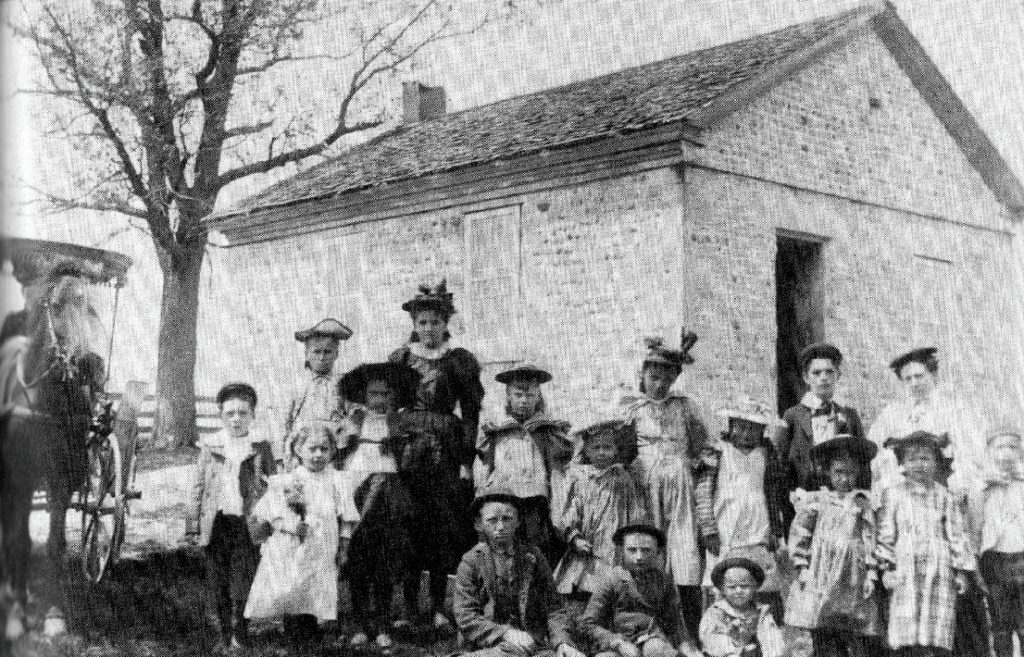
Many remembered that when they arrived there were several hundred of the Pottawattamie tribe living in this area of rich hunting lands and crystal-clear waters. Indeed, stories were passed down from the early congregants of the North and South Barrington Center churches, both built in 1853, of the occasional Native American wandering in and sitting on the back benches to listen to the preacher.
The first schoolhouse in this area is documented as being the Hendrickson, later Humphrey one-room school, opening in October 1835, located at Witt and Algonquin Roads. The log structure would also function as an early community center, and on November 23, 1840, four settlers, as required by law, posted a notice announcing an election to incorporate the township and elect school trustees.
The election was to take place at the home of William Otis, then a cabin along the trail where the Barrington United Methodist Church now stands. On December 14, 18 people arrived at the Otis home to cast their votes in the election to establish a local school system. Jesse P. Miller and William Van Orsdal served as judges and Homer Willmarth sat as clerk at the election. Barrington’s first school board was official. It consisted of five trustees: Phillip Hawley, Sr., Homer Willmarth (chairman), Thomas Perkins, John C. Allen, and William Graves. Jesse Miller was chosen as secretary.
On January 9, 1841, the same group met in the same one-room schoolhouse in this area first known as Miller’s Grove to divide the township into school districts that served as Barrington’s first form of government. The township was then referred to as Barrington precinct. Similar meetings occurred across the County Line Road in the later named Cuba and Algonquin Townships.
Consider the environment at this time. These settlers were in the middle of nowhere. In 1834, it would be another 20 years before the railroad arrived to establish Barrington Station at the Lake Cook county line. The river towns were in their infancy, crossing the river was by ferry. Occasionally it could be forded. Every member of the family worked from dawn to dusk for survival. Light was by candles or oil lamp, and heat by wood stove. Many recollected rain and snow blowing in between the loosely chinked logs of the one-room cabins. Wolves could still be heard howling at night; raising livestock was a precarious aspect of the settlers’ livelihoods.
But natural resources made up for the lack of goods until a general store, a blacksmith shop, a wagon repair shop, and a post office opened where the Chicago-to-Freeport mail and stage stopped at the junction of Dundee and Algonquin Roads, later known as Barrington Center. Wild game, fishing in the clear waters of streams and lakes, stands of good timber (the circa 1838 General Land Office map, the first to delineate the township and its sections) marks those natural resources. Once cleared, the prairie land was good, lending itself to cultivation, providing extra grain for trading. There was a support system, and the settlers had brought many skills with them.
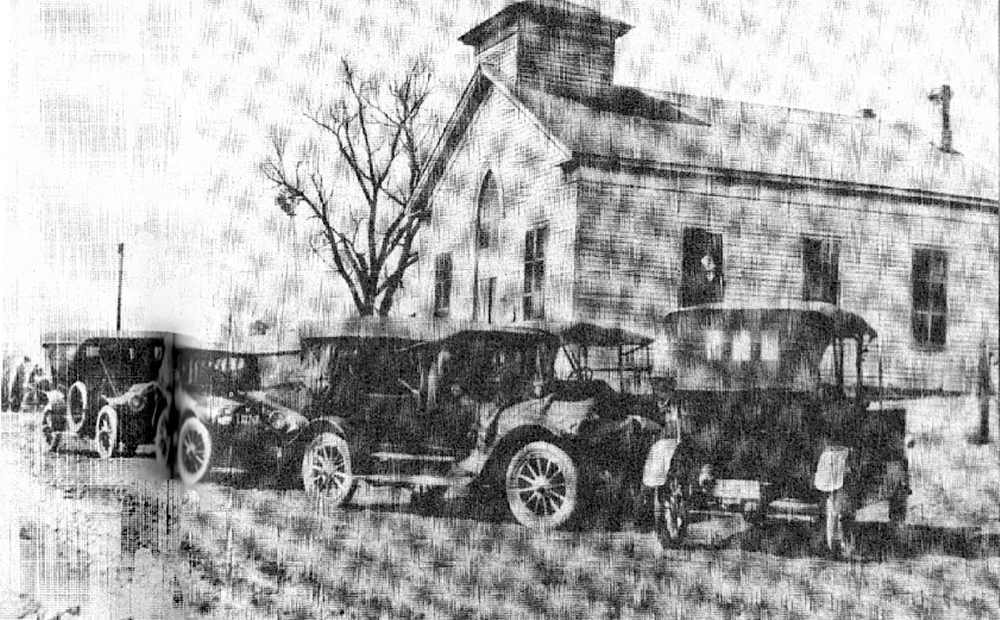
Some had the advantage of education and participation in the local governments of their original homes. This background of law and order can be seen in the surviving documents that recorded the establishment of the school districts and the township itself in 1850. The neat and steady writing as the pen was rhythmically transferred from the inkwell to the page; the recorded details undisputed and attested to by the votes of those gathered in the candlelight.
There came into this area in the late 1830s and 1840s, some of the families whose names would resonate through the years in the township, and later the Village of Barrington. Phillip Hawley, Sr. and his 12 children; William F. Waterman, and George T. Waterman. Some Waterman descendants remain here to this day. The Kingsleys, the Willmarths, and several Millers, thus Miller’s Grove appears on the earliest maps. Gilbert Applebee came from Canada in 1837, and had nine daughters who married out into the other settlers’ families. Benjamin Richardson (his descendants also remained in Barrington), and George M. Jackson.
In December 1849, Sheriffs notices went out that townships had to organize and elect their officers and certify their names by April of 1850. Thus, on Tuesday, the Second Day of April, 1850, a Meeting was posted for the Barrington Center schoolhouse to elect the officers. William Adams was Moderator, and Jerome W. Kingsley the Clerk. The Annual Township meeting is held on this date, to this day.
At that meeting, the name of Barrington was formalized for the Township. None of those early settlers had actually come from Great Barrington, Massachusetts, but from the many surrounding towns, North and South Adams predominant among them. Adams would have been logical, but a section of Dundee had already claimed Adams, and according to State law, no two townships could bear the same name. Thus, with Barrington already in informal use, that was the decision. It has been noted in later years that Great Barrington, Massachusetts, was a gathering point for multiple families setting out on the westward trek together.
Local school government was in place, tracts of land that extended west and northwest towards the Fox River were gradually sold; $125 an acre was the going rate. Most settlers put down roots, but some were dazzled by stories of “el dorado” and set out for the Far West. Occasionally they might return, either disillusioned, or, captivated by their experiences, collect their families, trust their fate to God, and begin their long journeys across the Continental Divide.
In 1853, the years of circuit riding preachers ended when Barrington Center North Church at Sutton and Dundee Roads was built by a Methodist Congregation and the Barrington Center South Church at Penny and Sutton Roads was built by a Congregational community. The direct heritage of both churches is found in Barrington today. The Barrington United Methodist Church is now very close to its roots at Algonquin Road and Route 59, its original church still in use by other congregations. The South Church no longer exists, but its 167-year history is vested today in the Community Church of Barrington.
1854 was a pivotal year for all of these outlands of Chicago. The extension of the Illinois and Wisconsin Railway, soon to become the Chicago and Northwestern Railway northwestward, and the founding of Barrington Station at the Cook and Lake County line, brought a passenger and freight connection to Chicago. As dairy farming increased, there were scheduled milk runs to Chicago dairies.
Some of the “senior” settlers moved into the new village; Jerome Kingsley, Homer Willmarth, Watermans, and Hawleys participated in early village government, while their sons continued to farm in the countryside. Throughout the 19th century, small and large tracts are recorded on the Plat maps, anywhere from 40 to several hundred acres. Some families had multiple scattered tracts. In the 1850s, Irish and German families became interspersed among those original Yankees; the Helms, Donleas, Brandts, Landwers, Gieskes, Riekes, and Weisemans (in Cuba Township) among the hardworking families who enriched township life.
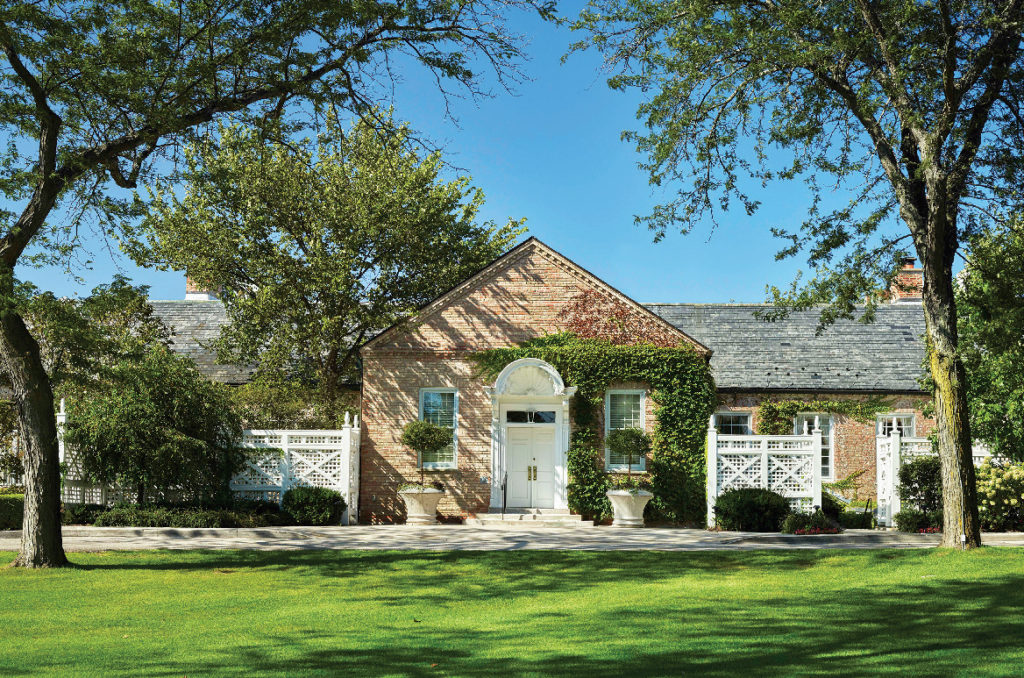
During the Civil War, the Barrington Center North Church was an important recruiting station, and on Decoration Day in 1933, a bronze tablet was dedicated, listing the names of 91 soldiers who had enlisted there. The Barrington Center Cemetery behind the north church contains the graves of 12 Civil War veterans. Others are buried in the Union Cemetery off of Algonquin Road.
The beginning of the Second Act for territory that would later become the Village of Barrington Hills could be found in the Worlds Columbian Exhibition of 1893. The great White City in Chicago was readily accessible by rail, even season tickets could be purchased, and visitors there saw visions for the future. Industry, education, and more conveniences for daily life inspired innovation, and aspiration.
By the early 20th century, many grain, dairy farms, and cheese factories that surrounded the Village of Barrington were becoming unprofitable, and were being offered for sale. In addition, the expansion of the Barrington Public School to include High School grades, offered a more advanced education, and schooling no longer stopped at the country school.
Possibly this inspired Sanford Peck to open a real estate office in the Railway Exchange building in Chicago around 1906. Many successful railroad entrepreneurs were headquartered there, and Peck evidently had an ear to the ground that some wanted to find country properties. He was surely persuasive, because Barrington then had none of the cachet that was associated with the North Shore. His clients’ first impressions after arriving on the train to be driven over rocky wagon trails was of farm fields, barns, silos, and simple frame houses.
So, who were they, this new wave of pioneers? They brought wealth, achievement, education, and imagination, and wanted to create a lifestyle for their families that embodied some quintessentially British traditions, but provided recreation, sport, and social activity in a quintessentially American way, unaffected through meritocracy rather than inherited privilege.
Three names stand out from those times. Harry Stillson Hart was the president of Rodgers Ballast Car Company and bought the Dodge and Comstock farms in 1907. These lay west of the village between County Line Road and the Northwestern Railway. With a beautiful residence completed by 1915, and his family settled there, Hart went into dairy farming and leased his herd to the Borden Company.
George E. Van Hagen, president of the Standard Forgings Company, and his wife, Mary Wakefield Van Hagen, bought their 300-acre farm further west on County Line Road. Their elegant mansion, restored, is now listed on the National Register of Historic Places. Van Hagen too, took to dairy farming, and built a model barn, with cork floors and curtains at the windows for the greater comfort of his cows.
In 1907, in Barrington Township, Spencer Otis, Sr. president of the National Boiler Washing Machine Company—according to farm sale records donated to the Barrington Historical Society by Sanford Peck’s grandson Don Schroeder—purchased six farms along Brinker Road, and the road that has carried his name (not the earlier Otis), Otis Road. His residence, Hawthorne Hill, now Rosewood, gave its name to a prize herd of Guernsey cattle.
These three were quickly followed by others; attested to by the early membership roster of the Barrington Hills Country Club, chartered in 1921. With 220 acres of land purchased from the Hart, Van Hagen, and Cardwell properties, this new club in the country represented their dream of more than just a putting green; it was to be family oriented, and the golf course quickly won acclaim for its design.
As the golf club became a recreational and social center for this scattered community, which extended to the Fox River, the children discovered how pleasant it was to ride horses between their properties. Thus was born the equestrian tradition of the Hills. Some original pioneer families remained on their land, often bemused by the sight of the well-dressed young ladies and gentlemen on gleaming horses. But many gladly went to work for the new stewards of the land.
Affluent, these new pioneers commissioned well-known architects to design stately new residences for them or adapt older farmhouses as weekend retreats. Landscape architects turned vegetable patches into beautiful gardens, open to public tours, organized by The Garden Club of Barrington, founded in 1925. Its members had bravely wrestled farmland into formal English and French style gardens, while others, notably the Robert Works, and the Alexander Reichmanns, were among the first to restore some native prairie landscapes. Thomas Howell commissioned the renowned landscape architect Jens Jensen to create natural vistas on his Otis Road property.
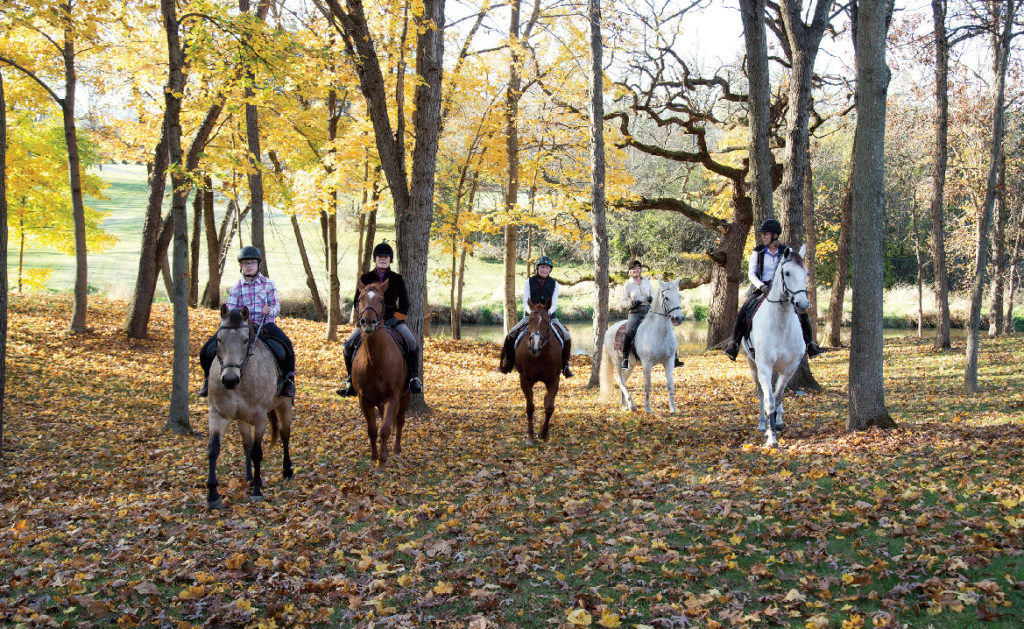
By the mid-1930s, there was a surge in the Barrington area of what the Chicago Sunday Tribune called “urban agriculturalists”. Over a four-year period from 1934 until 1937, over 14,000 acres changed hands in the north, south, and especially west of Barrington. Equestrian pursuits had steadily increased, and a formal trail system had evolved, maintained by its users, as many trails crossed through private property. There were horse shows and informal gymkhanas on the larger estates, and equestrian instruction was offered at the Round Barn off of Otis Road, now owned by Orville Caesar, president of the Greyhound Corporation, who had acquired many of the Spencer Otis farms.
The Townships provided governmental services to these unincorporated areas, as they had done since 1850. But with civic events increasing in the areas west of the Village of Barrington, the Countryside Association was formed in 1936 to address residents’ concerns.
The Riding Club of Barrington Hills was founded in 1937, and its first task was to formalize the trail system with easements and responsibility for maintenance by the Club itself. Those well-ridden neighborly paths were the foundation of the remarkable trail system secured by deeds and easements over private property and the Forest Preserves of Cook County that remains a model of public/private partnership today.
Around the same time, the Hunt was becoming popular. As the North Shore communities turned into more closely built suburbs, the Hound Masters sought alternative territory. With their good contacts, their logical destination was Barrington. Again, property owners had to give permission for the Hunt to build jumps on their land, as riders crossed the countryside to follow their hounds.
Membership in the Riding Club and the Fox River Valley Hunt was virtually synonymous. The Barrington Hills Country Club had been the first societal organization in the west countryside; it was followed by the Countryside Association, then the Riding Club and then the Fox River Valley Hunt. Boards and memberships were largely an address book of the Hills. Perhaps without realizing it, they were the nucleus for the formal organization of local government that became necessary after the Second World War.
The need for new and affordable housing outside of deteriorating cities saw developers searching the countryside for available land. Leonard Besinger found willing sellers, including Curtiss Farms, along the eastern side of the Fox River between Algonquin and Dundee. Soon hundreds of acres of timber were being felled and cleared for prefabricated houses on 60-foot lots. The development was called Meadowdale, and members of the equestrian community and the Countryside Association daily watched as 300-year-old oak trees were being felled and rolling hills leveled.
Gaining not-for-profit status in 1946, the Riding Club strengthened the proposals of the Countryside Association for the incorporation of large sections of land as the Village of Barrington Hills. They had already incorporated the smaller Village of Middlebury to the west in 1953. Now it became imperative for local enforceable land use ordinances. Besides the Meadowdale experience, the breakup of many large estates to smaller parcels needed local supervision. New owners of the smaller parcels wanted an equestrian lifestyle, but they needed to be acquainted with the traditions and protocols of the countryside. The Riding Club of Barrington Hills, as in its early days, took on a diplomatic role towards the new residents.
According to Victoria Fitch, in her book, “Hark Back to Barrington: A History of the Fox River Valley Hunt”, the organization and incorporation of the Village of Barrington Hills in 1957 should be credited to five remarkable men. Andrew Dahlstream, a lawyer who was then secretary of the Fox River Valley Hunt and chairman of the Cook County Zoning Board of Appeals; Newton Noble, a long-time resident of Bateman Road who was then president of the Countryside Association; Harold Byron Smith, who was president of Illinois Tool Works, and a respected and active member of every countryside organization; Thomas White, a long-time resident of Sutton Road and Master of Foxhounds from 1954-1958; and Orville Caesar, president of the Greyhound Corporation and owner of the Round Barn Riding Center and Dorvillee Farms along Otis Road.
Once the legalities for incorporation were in place, it was necessary to collect 300 resident signatures, and the above five men took an active part in this as they went door-to-door, the exercise later recounted in chuckling understatement by Harold Byron Smith. The articles were formalized, and the incorporation was completed on July 5, 1957. Andrew Dahlstream was elected first board president, and Harold Byron Smith was the second president. At the second meeting the board voted to formalize 5-acre zoning within the village boundaries, which at 28.6 square miles then, was the largest in the United States. Commercial development was also excluded from the village.
As areas surrounding the Village of Barrington incorporated, Deer Park also in 1957, and Lake Barrington, North Barrington and South Barrington in 1959, all except for Barrington Hills had one-acre minimum zoning standards. Some unincorporated areas in Cuba Township still have 5-acre zoning under Lake County governance. But clearly, countryside was changing to semi-rural and suburban, and there was a need to address civic issues. Much as the Countryside Association functioned west of the village, so in 1966, a group of community leaders formed to create the Barrington Area Development Council, whose mission was to look at unmet needs of the greater community, and to facilitate the formation of associations to address those needs.
Most importantly for the Village of Barrington Hills was the creation in 1971 of the Barrington Area Council of Governments. (BACOG). This created a unified voice to address the high density and incompatible development proposals that came in for any large undeveloped parcel of land. Fortunately for Barrington Hills, and through good relationships with County officials, even before incorporation, the Forest Preserves of Cook County already owned a large tract between Donlea, Sutton, County Line, Bateman, and Algonquin Roads.
Over the ensuing years, and through a growing understanding of conservation issues, the Forest Preserve holdings within the Village of Barrington Hills, have increased to over 4,500 acres. Some still large estates and private owned properties participate in conservation-oriented stewardship, through Citizens for Conservation, Barrington Area Conservation Trust, Spring Creek Stewards, and many more.
With the vibrancy of community life, centered in its historic recreational opportunities, the Village of Barrington Hills thrives. And this historian now passes the pen to Martin McLaughlin, Barrington Hills Village President, and Colleen Konicek Hannigan, Village President Pro-Tem and Village trustee, to write the present-day story and envision the future of this remarkable oasis, only 35 miles northwest of Chicago.
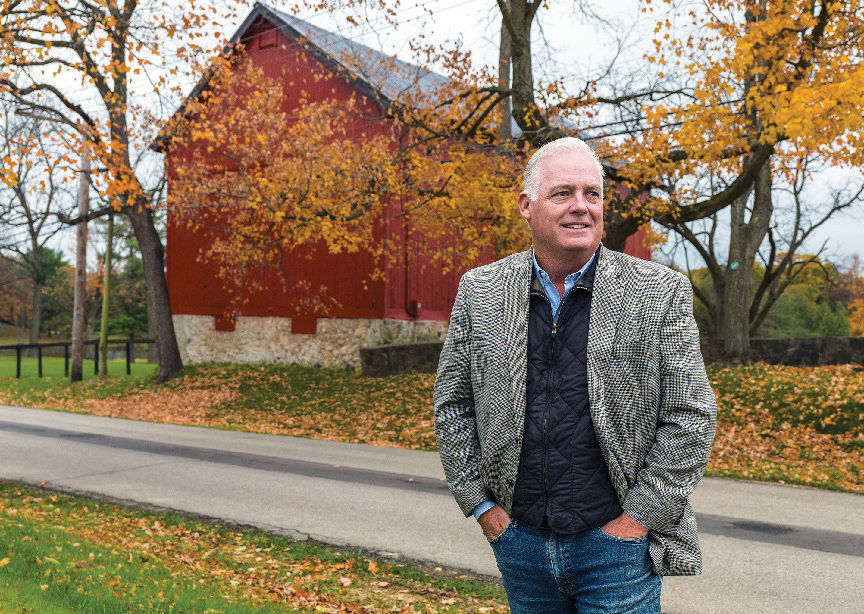
Head for the Hills! …to walk, to bike, to ride your horse. Imagine a serene morning run invigorated by the strikingly beautiful landscape, friends stopping by on horseback for a neighborly chat and afternoon cup of coffee, or a cool evening, warmed by the crackling flames of a bonfire at the shoreline of your private lake. Welcome to Barrington Hills!
I am excited to showcase our quiet village, where the crest of our hills unveils residents’ personal Eden, where they are welcomed home after the day’s hustle and bustle to the tranquility and haven of Barrington Hills. Our community is characterized as an oasis in an urban setting. This single-family residential community varies in many aspects: lifestyles, activities, architecture, and conservation.
Barrington Hills spans 29 square miles with a population of 4,209 and is ideally located just 20 minutes from O’Hare International Airport, 35 miles from downtown Chicago, with easy access to major highways and rail transportation. Enveloped in the rolling hills lie large properties showcasing homes and architecture as individualized as our residents.
As visitors travel through the Hills, they will see homes having incorporated historic barns, farmhouses, or silos into the main living space or restored to be preserved for years to come. Modern structures take advantage of the phenomenal hills and landscapes, boasting of unique design and distinction. Houses designed by renowned architects like Frank Lloyd Wright, Edward Dart, and their protégés, speak for themselves. A fun fact about Barrington Hills is that it has been the setting for many movies and most recently television dramas.
Mother Nature has chosen Barrington Hills as a canvas to display her grandeur: spectacular sunrises and sunsets span the horizon; night skies beckon a backyard observatory; mature, native trees don the season’s raiment, and wildlife embellish the hills throughout our village—all unobstructed thanks to our preservation of open spaces. The more than 100 privately-owned lakes and ponds bejewel the terrain, and welcome their homeowners to enjoy fishing, kayaking, swimming, or other water activities. Portions of our community enjoy 1,700 feet of Fox River shoreline connecting them to the Chain of Lakes, and with just under 5,000 square miles of Forest Preserve, there is no shortfall of outdoor activity.
Characteristics of the Hills inspire many to move here. What makes it especially different is our unique property freedoms. Barrington Hills parcels are mostly zoned minimum 5 acres which includes the use of land for agriculture. It’s no secret the Hills is known for its equestrian living, but what may not be common knowledge is residents enjoy the companionship of an assortment of animals: domestic poultry, goats, sheep, rams, llamas, buffalo…and yes, even a camel!
Another notable aspect of agriculture here in the Hills, which I’m sure is familiar to readers, are the master gardens in Barrington Hills—both botanical and organic—that have been featured in the pages of Quintessential Barrington and other publications. Homeowners enjoy their private apiaries and the benefits of their organic commodities.
The Hills equestrian heritage is clearly visible. Horses can be seen grazing in pastures, practicing show jumping or dressage, or with neighbors on a mount exploring over 150 contiguous miles of the Village’s private and public equestrian trail system. Residents enjoy housing, raising, riding, and breeding horses on their own properties. Local equestrian organizations maintain interests in horseback riding and equestrian traditions and welcome the public to annual events. The LeCompte/Kalaway Trailowners Polo Cup, the Fox River Valley Pony Club Horse Trials, or the Massbach & Fox River Valley Hounds’ historic horses riding-to-hounds exercises are among the most popular. Residents are just as likely to see the crisp red jacket and black helmet of a rider in the simulated fox hunt as they are to see the red and black plumage from a male sandhill crane. I stress the word simulated; we love our fox and all wildlife that grace our skies or traverse through our Village.
Our property allowances have enabled our community to foster various lifestyles: a sport court for family fun, a helipad to facilitate business trips, galleries to showcase cherished collectables, or target practice for the American sportsman. Open spaces safeguard resident privacy where they can enjoy their grounds for simple pleasures or for gatherings as modest or grand as they choose.
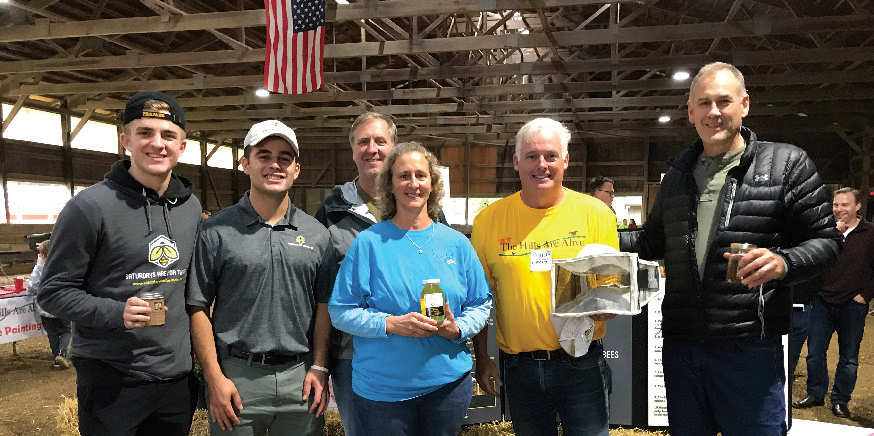
I grew up in Campton Township, rural St. Charles, surrounded by farms, horses, hills on one and a half acres with two sisters, a brother, and a horse named Starfire. In 1979, I attended Elgin Academy not realizing the deep history and connection between the Academy and the families of Barrington Hills’ founding fathers. My first friends then were the Flannery and Konicek families, who remain my close friends today. Colleen Konicek Hannigan and I served on the Elgin Academy Student Body of Government, and 32 years later, we ran together for Village Government and have served for the past eight years.
A fortuitous event was when my wife, Kathleen, transferred to Elgin Academy my junior year and I saw her cross the tennis courts—that was it for me. Nine years later, we had our wedding on the grounds of her parents’ home in Barrington Hills, which rivaled any destination wedding venue.
In 2005, it came time to consider the site of our permanent home. After visiting St. Charles, which had evolved from open space into suburbia, we returned to my wife’s hometown of Barrington Hills—a place filled with tradition, family, friends, and a welcoming community.
When taking office, Colleen and I established The Hills Are Alive Fall Festival. The idea was to bring our community together, highlight features of our Village, and share an afternoon of camaraderie. Eight years later, residents continue to make the Fest an annual tradition. We thank our generous donors and volunteers who make it all possible.
The Village of Barrington Hills’ Boards, Commissions, and Committees are all comprised of pro bono resident volunteers. Their affinity for our Village is evident through their many hours of selflessness and dedication. It is through these caring people that our Village has defined and maintained its goals. Our “do more with less” mindset has benefitted our residents financially, provided for streamlined services, and embraced community involvement.
Barrington Hills has always had the objective to maintain a balanced relationship between people and nature by acting as stewards to safeguard the environment for future generations. I like to say Barrington Hills was “green” before it was cool to be green.
As encroachment in surrounding areas has taken place, together with Village Trustees and Commission Volunteers, we have constantly defended and protected the open space environment and will continue to do so for many years to come. Our objective is to make certain that our values protect our 29 square miles to look the same today, as they did 50 years ago, and well into the future. The Village of Barrington Hills has tirelessly worked to follow our sustainability goals:
The Village of Barrington Hills takes pride in partnering with environmental organizations and instituting their recommendations to assist in achieving our goals. We have partnered with Citizens for Conservation, Barrington Area Conservation Trust, and Flint Creek/Spring Creek Watersheds and support their recommendations. We are one of the first Bee City USA affiliates in Illinois, fostering ongoing awareness of the role pollinators play in communities, and supporting initiatives to provide healthy pollinator-sustaining habitats.
I would encourage readers to experience the vast public open spaces contained within our Village, to discover the many clubs, organizations, and opportunities to participate, and research the history and engage in discovering your possible Eden in Barrington Hills.
Martin McLaughlin is a small business professional and a financial expert. His career has been in the financial market industry in which he currently serves as President/CEO of an investment firm. He graduated from Illinois Wesleyan University with a Bachelor of Science degree in Business Administration.
McLaughlin has served as Village President of Barrington Hills since 2013 where he implemented the approach of running government like a business, which has resulted in reduced spending, streamlined services, and a reduction of over 24% in the tax levy. Under his tenure, the Village’s Comprehensive Plan was updated, reinforcing the Village’s values, objectives, and future plans.
McLaughlin, in the Illinois November 2020 general election, was elected to represent residents and businesses in the 52nd District. He chose to run upon the announcement that Representative David McSweeney would not seek reelection. McLaughlin wants to bring his commonsense approach to Springfield to curtail the ever-increasing tax burdens imposed on Illinois residents and businesses. McLaughlin will finish out his term as Village President of Barrington Hills.
He and his wife, Kathleen, have lived in Barrington Hills since 2005, and have raised their five daughters ages 14-27 in Barrington Hills. The four oldest have graduated from Barrington 220 schools. Their youngest daughter is currently attending Barrington Middle School-Station Campus.
McLaughlin has been an active member of the community, serving as chairman of the Barrington Area Council of Governments, and participating as a member of the Executive Board of the Barrington Lions Club. He has also spent time coaching soccer and softball and has attended many events on the sidelines.
At the age of 4, my family moved from Norridge, Illinois, to a home on Old Sutton Road in Barrington Hills with a barn, apple trees and grape vines, sheep, and a horse. In summer we ran through the fields to catch fireflies, fished in the creek that ran through the pasture, hopped rides on our pony, Swapper, and fed ourselves from the fruit trees and berry bushes. We road our bikes down Old Sutton to Tricia Lane, where together with our neighbors, a field had been transformed into a regulation sized baseball diamond, complete with backstop.
In the back of our pasture, we had a pond where my uncle, an electrician, helped us to string lights so we could have hockey matches into the night during the winter. The barn provided constant entertainment for Evil Knievel stunts from the loft to piled up hay below. A log in the pasture provided hours of wonder watching a ladybug habitat. When I was nine, we moved to Oak Knoll Road, and, without a barn, the horses and pony were left with friends. But in losing the barn, we didn’t lose our love for horses and friends would often ride up into the yard from the horse trail to greet us in the morning.
On summer mornings we would take a makeshift raft down Flint Creek and pretend to be adventuring like Huck Finn. On winter afternoons, we’d lace up our skates and skate from neighbor’s pond to neighbor’s pond to see who had the smoothest ice. Have you ever played hide-and-seek in a field so thick with fog you can’t see your own hand in front of your face? Or looked up in the sky to see the beautiful hot air balloons floating across only to watch one slowly descend into your backyard where you are invited to help deflate the balloon with the chase crew?
This is the splendor of growing up in Barrington Hills. And, of course, the day we all waited for, was to hear the blowing of the horn, hounds barking from across the field and see the splendor of the horsemen and women in their red and black jackets ride across the field. This is the best playground a child could ever dream of—all in your backyard. Welcome home!
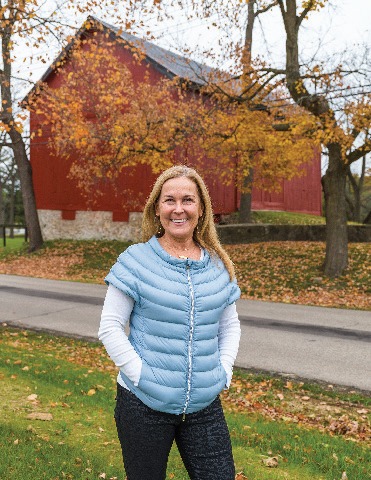
Hannigan moved to Barrington Hills in 1969 and returned after marriage to live in Barrington Hills in 2005. She is a partner at Fletcher & Sippel, LLC where she practices law representing clients in transportation industries. She is an avid distance runner enjoying the Barrington Hills village roads. Colleen is a founder of the veteran charity event Barrington Honor Ride and Run and is a member of the Barrington Play Reading Group.
Share this Story